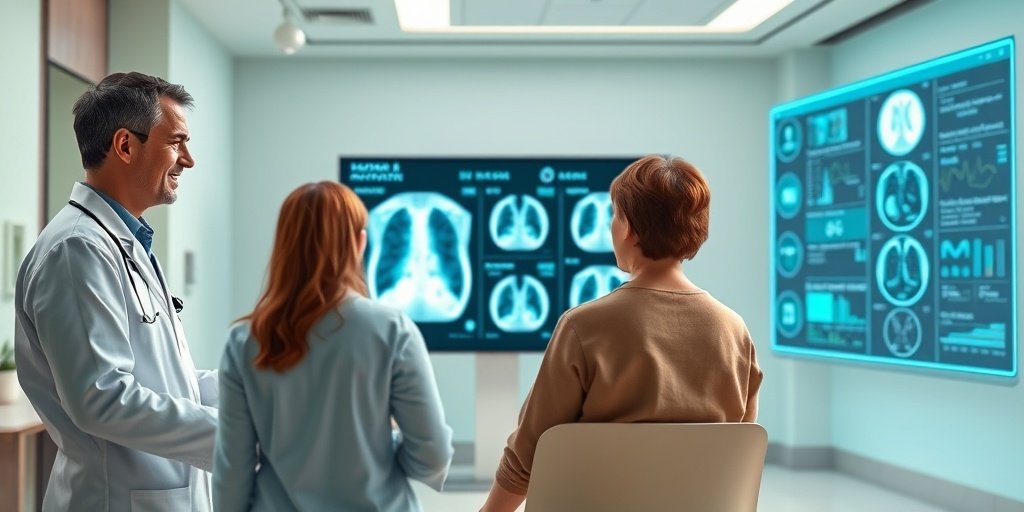⚡ Quick Summary
This article emphasizes the importance of shared decision-making (SDM) in radiology, highlighting how leadership can drive its integration into clinical practice. By implementing innovative strategies, radiology can enhance patient-centered care and improve outcomes.
🔍 Key Details
- 📊 Focus: Shared decision-making in radiology
- 🧩 Key Strategies: Access to imaging data, patient-friendly summaries, direct communication
- ⚙️ Innovations: AI-driven tools, patient-reported outcome measures
- 🏆 Leadership Role: Transformational leadership to embed SDM
🔑 Key Takeaways
- 📈 SDM is crucial for patient-centered care in radiology.
- 💡 Leadership interventions can significantly enhance the role of radiologists in decision-making.
- 🗣️ Direct engagement with patients is essential for preference-sensitive decisions.
- 🤖 AI tools can support patient understanding and improve communication.
- 🚧 Barriers such as workflow demands and medicolegal uncertainties need addressing.
- 🏥 Training and incentives are necessary for effective SDM integration.
- 🌍 Radiology’s role in care pathways is pivotal for enhancing patient outcomes.
- 🔄 Cultural change is required for meaningful SDM implementation.

📚 Background
Shared decision-making (SDM) is a fundamental aspect of patient-centered care, yet it remains underutilized in the field of radiology. This gap highlights the need for innovative strategies that empower radiology leaders to foster a culture of collaboration and informed decision-making between patients and healthcare providers.
🗒️ Study
The article synthesizes various case examples and evidence from different imaging scenarios, aiming to translate research into actionable strategies for radiology leaders. It evaluates emerging innovations and identifies leadership levers that can facilitate the integration of SDM into everyday clinical practice.
📈 Results
The findings indicate that leadership interventions can significantly transform radiology’s contribution to SDM. For instance, cases involving incidental pulmonary nodules and breast MRI in familial risk demonstrate how radiologists can engage in preference-sensitive decisions. Key strategies identified include improving access to imaging data and utilizing patient-friendly summaries to enhance understanding.
🌍 Impact and Implications
The implications of this study are profound. By embedding SDM into training, workflows, and systems, radiology can evolve into a model of cutting-edge, patient-centered care. This shift not only enhances patient engagement but also improves overall healthcare outcomes, making radiology a vital player in the patient care continuum.
🔮 Conclusion
This article underscores the transformative potential of shared decision-making in radiology. By leveraging leadership and innovative strategies, the field can enhance its role in patient-centered care. The future of radiology lies in its ability to adapt and embrace these changes, ultimately leading to better patient experiences and outcomes.
💬 Your comments
What are your thoughts on the integration of shared decision-making in radiology? We would love to hear your insights! 💬 Join the conversation in the comments below or connect with us on social media:
Shared decision-making in radiology: leadership levers for patient-centred imaging.
Abstract
BACKGROUND: Shared decision-making (SDM) is a cornerstone of patient-centred care, yet it has been underused in radiology.
OBJECTIVE: To translate research into innovative strategies to empower radiology leaders to apply SDM and outline the cultural and structural changes required for meaningful integration into clinical practice.
METHODS: This article synthesises case examples and evidence across imaging scenarios, evaluates emerging innovations and highlights leadership levers that can embed SDM as a core practice in radiology.
RESULTS: Leadership interventions can transform radiology’s contribution to SDM. Cases such as incidental pulmonary nodules, breast MRI in familial risk and Li-Fraumeni syndrome illustrate how radiologists can engage directly in preference-sensitive decisions. Key strategies include improving access to imaging data, using patient-friendly summaries, expanding opportunities for direct communication and incorporating patient-reported outcome measures, patient-reported experience measures and artificial intelligence (AI)-driven tools to support patient understanding. Barriers such as workflow demands, medicolegal uncertainty and lack of incentives can be addressed through leadership-driven reforms.
CONCLUSIONS: Radiology plays a central role in care pathways, offers clinical and technical expertise and increasing patient-facing innovation. Leaders who embed SDM into training, workflows and systems can enhance radiology as a model of cutting-edge, patient-centred care. Clear actions include training, protected time, incentives, strategic application of AI and transformational leadership.
Author: [‘Kamran R’, ‘Doria AS’]
Journal: BMJ Lead
Citation: Kamran R and Doria AS. Shared decision-making in radiology: leadership levers for patient-centred imaging. Shared decision-making in radiology: leadership levers for patient-centred imaging. 2025; (unknown volume):(unknown pages). doi: 10.1136/leader-2025-001400